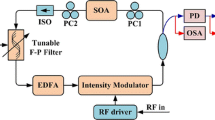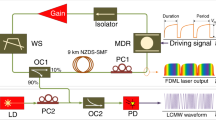Abstract
We report the experimental observation of harmonic mode locking of a dual-wavelength all-fiber laser with different repetition rates. Dual-wavelength mode locking with individual fundamental repetition rates could be generated in the laser. By adjusting the intracavity polarization controller, harmonic mode locking of both wavelengths can be generated, and the difference of harmonic repetition rates is stable. This investigation not only enriches the nonlinear dynamics of mode-locked lasers, but also has potential applications related to the dual-comb based on a free-running fiber laser.
Access provided by Autonomous University of Puebla. Download conference paper PDF
Similar content being viewed by others
Keywords
1 Introduction
Passively mode-locked fiber lasers have been investigated intensely, due to their important applications in many fields. As ultrashort optical pulse sources, they show the advantages of low-cost, compactness, and stability. In addition, the mode-locked fiber lasers are ideal platform for nonlinear science investigations [1]. An interesting phenomenon in passively mode-locked fiber laser is that pulse trains with different repetition rates can simultaneously exist in a single cavity. In 2008, an all-fiber bidirectional mode-locked laser was proposed, where the pulses could operate in both directions since there is no isolator in the cavity [2]. Birefringence-induced asynchronous pulse trains with different polarization states were also investigated in fiber lasers. For example, pulse trains with orthogonal polarizations were proposed in a unidirectional fiber laser [3]. Pulse nonlinear dynamics was also reported in the fiber lasers with asynchronous pulse trains. Bound solitons was observed in a bidirectional mode-locked fiber laser [4]. Coexistence of dissipative soliton and stretched pulse was reported in a dual-wavelength fiber laser due to the significant wavelength-dependent net cavity dispersion [5].
Fiber lasers with asynchronous pulse trains have promising applications in many fields, especially serving as a simple dual-comb source. Sharing the same cavity, there is inherently mutual coherence between the two pulse trains [2]. Bidirectional fiber laser was proposed for fiber Bragg grating interrogation, which can be used for multiplexed static strain sensing [6]. Dual-comb spectroscopies were demonstrated by use of a free-running bidirectionally fiber laser [7] and a dual-wavelength fiber laser [8], respectively.
Mode-locked fiber lasers usually generate multiple pulses due to wave breaking. An interesting and special regime of multiple pulse is passive harmonic mode locking observed in 1993 [9], where all the output pulses are equally separated and the pulse repetition rate is multiple of the fundamental repetition rate. For the applications such as dual-comb distance measurement, the increases of repetition rate will improve the performance, e.g., shortening the refresh time.
In this paper, harmonic mode locking is investigated in a dual-wavelength all-fiber laser with asynchronous pulse trains. The difference of repetition rates is larger than the case operating with fundamental repetition rate. Further measurement shows that the difference of repetition rates is stable.
2 Experimental Setup
Figure 1 shows the experimental setup. The fundamental repetition rate is ~39 MHz. The laser is passively mode-locked by the combination of nonlinear polarization ration (NPR) and carbon nanotube (CNT). The CNT, placed between two fiber ferrules to form a saturable absorber, mainly contributes to the mode locking. Meanwhile, two polarization controller (PCs) and a polarization-dependent isolator (PD-ISO) form NPR, assisting the mode locking.
3 Experimental Results
By properly setting the PCs, mode locking (with single pulse train) can be achieved at two different central wavelengths, respectively. Furthermore, dual-wavelength mode locking with individual fundamental repetition rates (around 39 MHz) could be generated in the laser. In the case of dual-wavelength mode locking, by further adjusting the PCs, up to several tens order harmonic mode locking at one of the wavelength could occur, while the other wavelength keeps operating at fundamental repletion rate. More interestingly, harmonic mode locking of both wavelengths can also be generated, which double the repetition frequency difference of that at fundamental repetition.
To investigate the stability of the dual-comb based on the dual-wavelength fiber laser, the difference of two repetition rates of harmonic mode locking are measured in a period of time. As shown in Fig. 2, the repetition rates (twice of the fundamental repetition rate) of the two wavelength drifts in similar tendencies, which results in a small drift of \( \Delta f \) with standard deviation of 5 Hz.
4 Conclusion
Benefiting from the saturable absorption mechanism provided by the combination of CNT and NPR, harmonic mode locking of asynchronous pulse trains with different wavelengths is achieved in an all-fiber laser. The stability of the repetition rate difference is experimentally confirmed, the standard deviation of which is about 5 Hz. Our work provides a potential way to enlarge the repetition rates, as well as the difference of repetition rate, of dual-comb based on a single cavity, which may benefit the applications of dual-comb.
References
Grelu P, Akhmediev N (2012) Dissipative solitons for mode-locked lasers. Nat Photonics 6:84
Kieu K, Mansuripur M (2008) All-fiber bidirectional passively mode-locked ring laser. Optics Lett 33(1):64–66
Zhao X, Li T, Liu Y, Li Q, Zheng Z (2018) Polarization-multiplexed, dual-comb all-fiber mode-locked laser. Photonics Res 6(9):853–857
Li L, Ruan Q, Yang R, Zhao L, Luo Z (2016) Bidirectional operation of 100 fs bound solitons in an ultra-compact mode-locked fiber laser. Opt Express 24(18):21020–21026
Wang Y, Li J, Hong L, Li G, Liu F, Zhou X et al (2018) Coexistence of dissipative soliton and stretched pulse in dual-wavelength mode-locked Tm-doped fiber laser with strong third-order dispersion. Opt Express 26(14):18190–18201
Guo J, Ding Y, Xiao X, Kong L, Yang CJO (2018) Multiplexed static FBG strain sensors by dual-comb spectroscopy with a free running fiber laser. Optics Express 26(13):16147–16154
Mehravar S, Norwood RA, Peyghambarian N, Kieu K (2016) Real-time dual-comb spectroscopy with a free-running bidirectionally mode-locked fiber laser. Appl Phys Lett 108(23):231104
Zhao X, Hu G, Zhao B, Li C, Pan Y, Liu Y et al (2016) Picometer-resolution dual-comb spectroscopy with a free-running fiber laser. Opt Express 24(19):21833–21845
Grudinin AB, Richardson DJ, Payne DN (1993) Passive harmonic modelocking of a fibre soliton ring laser. Electron Lett 29(21):1860–1861
Acknowledgements
This work was supported by the National Key Scientific Instrument and Equipment Development Project of China under Grant 2014YQ510403, and by the National Natural Science Foundation of China (NSFC) under Grant 51527901.
Author information
Authors and Affiliations
Corresponding author
Editor information
Editors and Affiliations
Rights and permissions
Copyright information
© 2021 Springer Nature Singapore Pte Ltd.
About this paper
Cite this paper
Huang, X., Cao, B., Xiao, X. (2021). Harmonic Mode Locking of Dual-Wavelength Mode-Locked All-Fiber Laser. In: Xu, L., Zhou, L. (eds) Proceedings of the 8th International Multidisciplinary Conference on Optofluidics (IMCO 2018). IMCO 2018. Lecture Notes in Electrical Engineering, vol 531. Springer, Singapore. https://doi.org/10.1007/978-981-13-3381-1_18
Download citation
DOI: https://doi.org/10.1007/978-981-13-3381-1_18
Published:
Publisher Name: Springer, Singapore
Print ISBN: 978-981-13-3380-4
Online ISBN: 978-981-13-3381-1
eBook Packages: EngineeringEngineering (R0)






